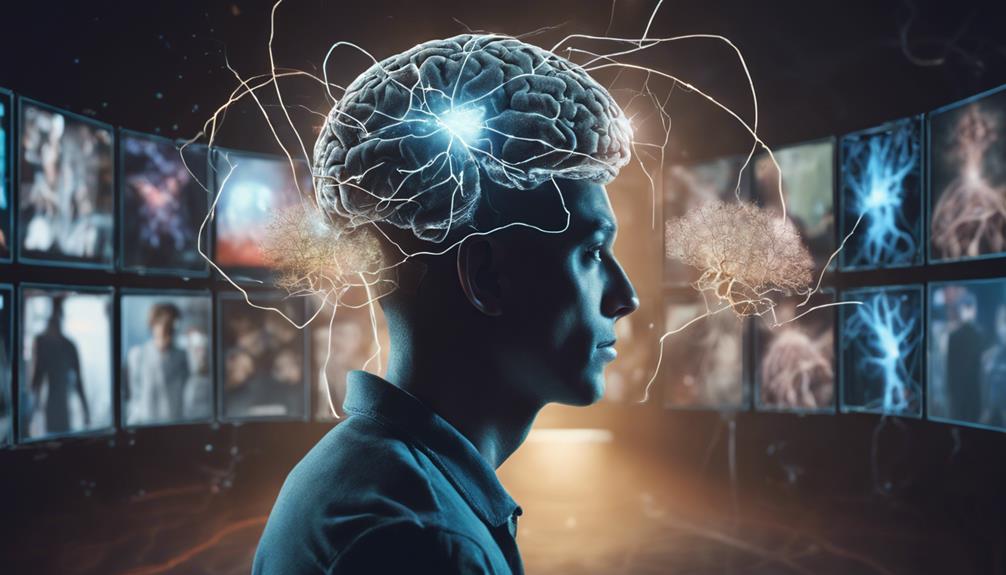Why Storytelling Formula Works So Well
You've heard the phrase "the power of storytelling," but what makes storytelling formulas so effective is their ability to tap into fundamental human psychology. By combining proven patterns and structures with emotional resonance, these formulas create deeply impactful experiences that resonate with you on a deeper level. When you hear a story, your brain recognizes patterns, anticipating what's next and making the narrative more engaging and memorable. Emotional connections are forged through vulnerable characters, universal themes, and authentic emotional payoffs, drawing you in and refusing to let go. The key to unlocking the full potential of storytelling formulas lies in understanding this complex interplay.
Key Takeaways
- The storytelling formula works by leveraging cognitive biases, such as nostalgia and familiarity, to influence audience perception and interpretation.
- Pattern recognition and structure make stories more engaging, memorable, and predictable, allowing audiences to anticipate what's next.
- Emotional connections and resonance are created through heartfelt story beats, emotional journeys, and universal themes that tap into audience emotions.
- The brain's neural network is wired to recognize patterns, making a well-structured narrative more likely to resonate and be consolidated into long-term memory.
- A balance between predictability and unexpected twists and turns creates a sense of anticipation, keeping audiences engaged and invested in the story.
The Power of Patterns
You often hear that storytelling is an art, but it's also a science that relies heavily on patterns.
These patterns tap into your brain's ability to recognize and respond to familiar structures, making storytelling more engaging and memorable. Pattern recognition is key to understanding why certain stories resonate with you.
When you're presented with a narrative that follows a familiar pattern, your brain quickly identifies it and fills in the gaps, allowing you to focus on the story's themes and messages.
Storytellers also use patterns to exploit cognitive biases, influencing how you perceive and interpret information.
For example, the hero's journey is a classic pattern that leverages the cognitive bias of nostalgia, making you more invested in the hero's quest. Similarly, the use of repetition and rhyme in children's stories exploits the cognitive bias of familiarity, making the story more enjoyable and memorable.
Emotional Connection Matters
As you craft your story, you're not just conveying information – you're creating an experience that can leave a lasting impact on your audience.
To achieve this, you'll want to incorporate heartfelt story beats that tap into human emotions, making your narrative more relatable and authentic.
Heartfelt Story Beats
Emotional connections are the heartbeat of any compelling story, and crafting heartfelt story beats is essential to drawing your audience in.
These beats are the moments that make your audience feel seen, heard, and understood, and they're what keep them invested in your story. When you create heartfelt story beats, you're not just telling a story – you're creating a shared experience with your audience.
To craft heartfelt story beats, focus on your characters' emotional journeys.
What're their deepest desires and fears? What do they stand to gain or lose? By understanding these character arcs, you can create moments that resonate with your audience on a deeper level.
These moments are often the emotional payoffs that make your story worth telling. When you nail these beats, you'll find that your audience is more engaged, more empathetic, and more likely to remember your story long after it's over.
Tapping Human Emotions
Behind every great story is a masterful manipulation of human emotions, one that creates an unbreakable bond between the audience and the narrative.
You're drawn into the story because it speaks to you on a deeper level, evoking feelings that resonate long after the story ends.
When a story taps into your emotions, it becomes a personal experience, making you more invested in the characters and their journey.
Emotional triggers and empathy drivers are the keys to creating this connection.
By incorporating elements that evoke strong emotions, you can craft a story that stays with your audience.
Here are three ways to tap into human emotions:
- Use relatable characters: Create characters that your audience can identify with, and they'll be more likely to become emotionally invested in their journey.
- Explore universal themes: Themes like love, loss, and redemption are universally relatable, making them powerful emotional triggers.
- Show vulnerability: Characters who show vulnerability and authenticity create a sense of empathy in the audience, drawing them into the story on a deeper level.
Emotional Resonance Deepens
When you're fully immersed in a story, the emotional connection you feel with the characters can linger long after the narrative ends.
This is because emotional resonance has the power to deepen your connection with the story, making it more relatable and memorable. Emotional authenticity is key to creating this resonance – when you see characters experiencing real emotions, you can't help but respond with empathy.
An empathetic response is a powerful tool for storytellers, as it allows you to tap into your audience's emotions and create a sense of shared understanding.
When you feel seen and heard through a character's struggles, you're more likely to invest in their journey and care about the outcome. This emotional investment is what makes storytelling so impactful, and it's why emotional resonance is such a crucial element of the storytelling formula.
Universality of Human Experience
When you craft a story, you're not just sharing a unique experience – you're tapping into a shared emotional connection that resonates with your audience.
We all face common life struggles, from overcoming fears to finding love, and these universal experiences create a bond between you and your listeners.
Shared Emotional Connection
You're about to tap into one of the most powerful storytelling tools – the shared emotional connection.
This is where universality of human experience comes alive, allowing your audience to connect with your narrative on a deeper level.
By tapping into the emotions that unite us, you create emotional intimacy, drawing your audience closer to your story.
A shared emotional connection is the foundation of collective empathy.
When your audience can relate to the emotions expressed in your story, they begin to invest in the characters and their journeys.
This connection makes your narrative more impactful, memorable, and engaging.
- Explore universal emotions: Focus on emotions that are common to the human experience, such as love, loss, or hope.
- Create relatable characters: Develop characters that your audience can identify with, flaws and all.
- Show vulnerability: Share vulnerable moments in your story to create a sense of authenticity and connection with your audience.
Common Life Struggles
Embracing the complexities of human experience, your storytelling can gain depth and resonance by exploring common life struggles.
By delving into the everyday fears and inner doubts that your audience faces, you can create a sense of universality and shared understanding. This can be a powerful way to connect with your audience on a deeper level and make your story more relatable.
When you tap into common life struggles, you're not just telling a story – you're reflecting the human experience.
Your audience will see themselves in your characters' struggles and root for them as they overcome obstacles. This can lead to a more engaging and emotionally resonant story that stays with your audience long after the narrative ends.
Brain's Response to Story
The brain's neural network is a storytelling powerhouse, and its response to a well-crafted narrative can be nothing short of remarkable.
When you're fully engaged in a story, your brain's neural pathways light up, releasing a cascade of synaptic triggers that stimulate your emotions, memories, and imagination.
This complex interplay of neural activity is what makes storytelling so compelling and memorable.
As you listen to or read a story, your brain processes the information on multiple levels, creating a rich and immersive experience.
Here are three ways your brain responds to a story:
- Emotional Resonance: Your brain's emotional centers are triggered, releasing feelings of empathy, excitement, or fear, making the story more relatable and memorable.
- Pattern Recognition: Your brain recognizes patterns and connections within the narrative, helping you to make sense of the story and anticipate what's next.
- Memory Consolidation: Your brain consolidates the story into your long-term memory, making it easier to recall and reflect on the narrative and its themes.
Structure and Predictability
Several key elements come together to create a compelling narrative, and structure is one of the most critical components.
When you hear a story, your brain is wired to recognize patterns, and a well-structured narrative is more likely to resonate with you. This is because our brains thrive on predictability, and a predictable narrative is more engaging and easier to follow.
Familiar frameworks, such as the hero's journey or a clear three-act structure, provide a sense of comfort and stability, allowing you to focus on the story itself.
A predictable narrative doesn't mean it's boring or unoriginal. On the contrary, a well-structured story can be both engaging and unpredictable at the same time.
The key is to balance predictability with unexpected twists and turns. When you use familiar frameworks, you create a sense of anticipation in your audience, and they become invested in the story.
Evolution of Storytelling
Millions of years of human history have witnessed the evolution of storytelling, from ancient oral traditions to modern digital platforms.
You've likely heard tales of Caveman stories passed down through generations, with each tribe member adding their own twist to the narrative.
These early stories not only entertained but also served as a way to share knowledge, cultural values, and historical events.
As civilizations developed, so did the art of storytelling. Ancient myths were born, filled with gods, goddesses, and supernatural creatures.
These stories were used to explain natural phenomena, the creation of the world, and the human condition.
The evolution of storytelling has been shaped by the mediums available to each era.
- Oral traditions (Caveman tales, ancient myths): Stories were passed down through generations by word of mouth.
- Print media (books, newspapers): Stories were mass-produced and distributed, making them more accessible.
- Digital platforms (social media, podcasts): Stories can now be shared instantly with a global audience.
Understanding the evolution of storytelling can help you appreciate the power of a well-crafted narrative and its ability to engage and inspire audiences.
Frequently Asked Questions
Can Storytelling Formulas Be Applied to Non-Fiction Writing?
You can apply storytelling formulas to non-fiction writing, incorporating memoir techniques to craft engaging narratives and using business anecdotes to illustrate key points, making your writing more relatable, memorable, and impactful.
How Do Cultural Differences Affect Storytelling Formulas?
You navigate cultural differences in storytelling by recognizing that cultural nuances shape local narratives, while universal themes, like love and redemption, transcend borders, allowing you to adapt formulas for diverse audiences.
Can AI Algorithms Create Engaging Storytelling Formulas?
You're wondering if AI algorithms can create engaging storytelling formulas. By analyzing narrative patterns, AI's imagination can generate unique storylines, adapting to diverse audiences and tastes, potentially revolutionizing content creation with personalized storytelling.
Do Storytelling Formulas Limit Creative Expression?
You might think formulas stifle creativity, but they can actually provide creative constraints, sparking innovative ideas within a structured framework, ultimately granting you formulaic freedom to experiment and express yourself in unique ways.
Can Storytelling Formulas Be Used in Public Speaking?
You can use storytelling formulas in public speaking to enhance speech patterns and boost audience engagement. By applying these formulas, you create a narrative structure that captures attention, builds connection, and leaves a lasting impression.
Conclusion
You've seen it time and time again – a well-crafted story that hooks you from start to finish. The reason storytelling formulas work so well is that they tap into fundamental patterns of human experience. By leveraging emotional connections, universal themes, and predictable structures, these formulas trigger a powerful response in your brain. As you engage with a story, you're not just entertained – you're experiencing a primal connection that resonates deep within.







